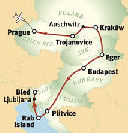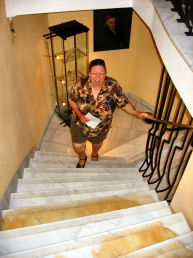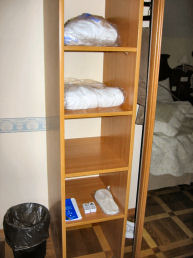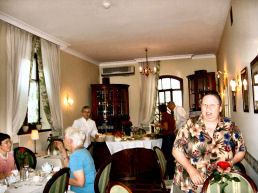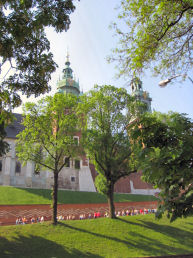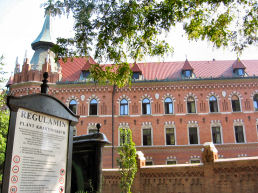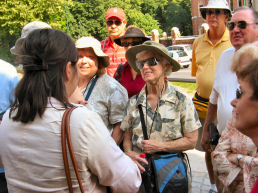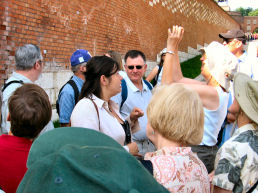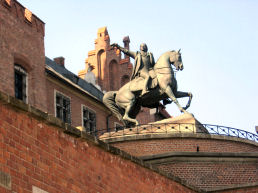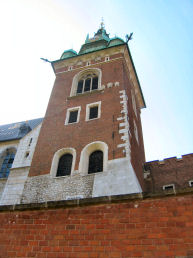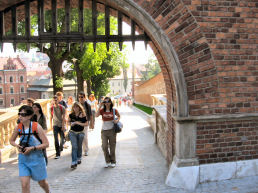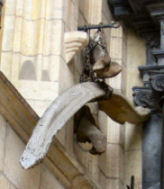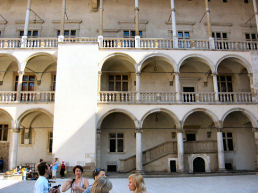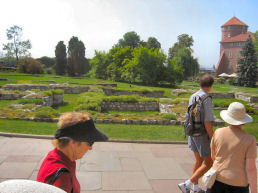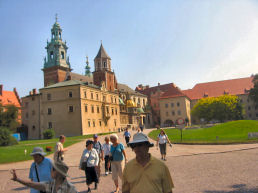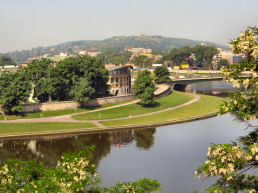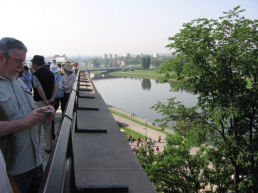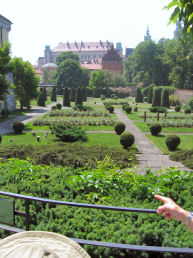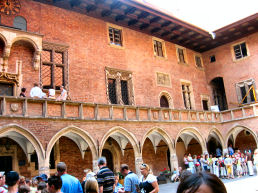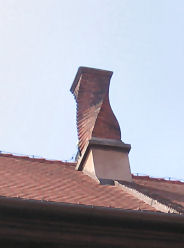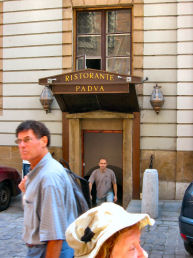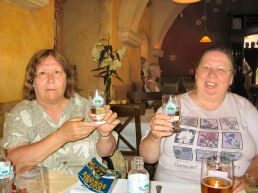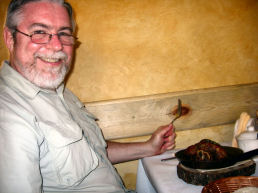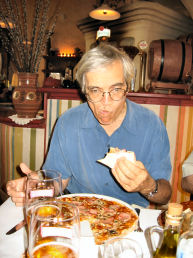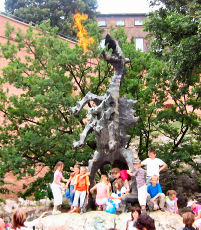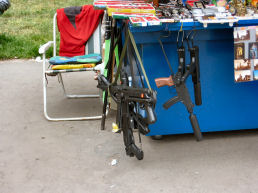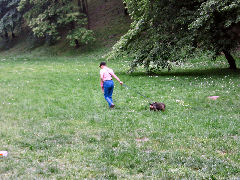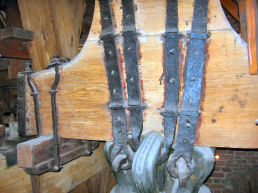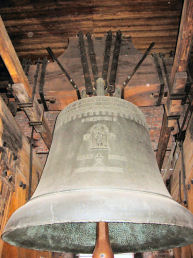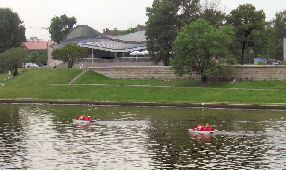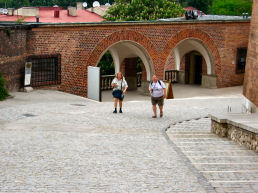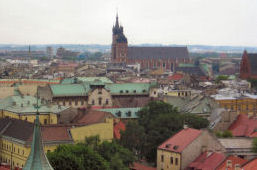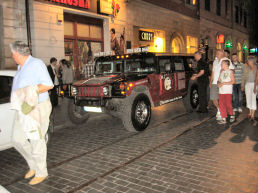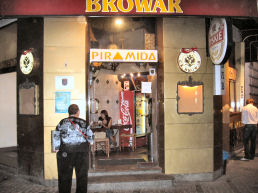The hotel’s breakfast room was not big enough to accommodate everyone at once. So, the group was forced to eat in shifts. A worse problem was that the tables were rather small. Sue and I were hoping to sit with someone new, so that we could get to know them a little better, but we ended up eating alone. The layout was quite good. There were no eggs this time, but there was meat for little sandwiches, cereal, yogurt, and plenty of fruit. The best thing about breakfast was the bowl of peaches. A breakfast with nothing but peaches would suit me fine.
Check that. There were two really good things about the breakfast. The other one was that the lady who was monitoring the area was happy to make any kind of coffee, including cappuccino, that you wanted.
At 9 a.m. we mustered for our walking tour of Kraków. Sue showed up for the assembly, even though she had decided to stay home and do laundry rather than participate in the walking tour. I thought that she had come down to tell her buddy, Marge, about her intentions. For some reason Sue thought that I was going to inform Marge that she was bailing out.Across the street from the hotel was the Planty. It formerly was the moat between the city’s outer wall and its inner wall. Now it served as a nice tree-filled park that went all the way around the Old Town. I resolved to use it for a jog either Friday night or Saturday morning. The guide book said that it was about 2.5 miles in circumference. I figured that I should be able to manage two or three laps without much difficulty.
Our local tour guide’s name was Kasia. She was a walking fountain of information about Poland. I really enjoyed her approach, and her English was excellent.
It was quite warm by then. It obviously was going to reach the 80’s, but Kasia was still wearing stockings, a skirt, and a light jacket. Even at the end of the tour at noon she seemed to have lost none of her cool. It may be considered de rigueur to dress up in her profession. Few Americans of my generation care much about that, but my dad would definitely have noticed and approved.
What a relief that none of the letters of Kasia’s name had diacritical markings. It has been such a pain to insert them into the text. I might have resorted to calling her Kathy.
Kasia explained that from the eleventh century through the eighteenth Poland was ruled by Kings and a parliament called the Seym. Then the country became part of the Austro-Hungarian empire. Poland regained its freedom after World War I. They were then conquered by Hitler. By some miracle Kraków escaped destruction during World War II even when Poland was "liberated by the Soviet army."
I saw a sticker on a car with the name Musiał. Since that last letter is pronounced like a w in Polish, I had difficulty imagining how Stan the Man’s name was pronounced before his family emigrated to the United States.
The tour began with a walk to Wawel Castle, which was only a few blocks from the hotel. The basic plan for defense in eastern European cities seemed to entail a walled city with a large castle on a hill beside it. The castle area evidently served as a sort of “Green Zone.” Even if the bad guys got into the city, everyone of any importance would be safe in the castle.On the way to the castle we saw the seminary in which Carol Wojtyła, the future Pope John Paul II, studied. The walk up the stairs to the castle was not very steep, but it was pretty long. It occurred to me that Sue would have wilted in this heat. Towering above the entrance to the castle was a statue of one of the heroes of the American Revolution, Taddeus Kosciusko, on a horse.
Kasia told us that Kraków had once been the capital of Poland, but then it was moved to Warsaw. Since Warsaw was destroyed during the war, it seemed surprising that the capital was not moved back. Warsaw and Kraków have evidently always been big rivals. Kasia said that it was like Florence and Rome. I thought that she needed a new analogy. The only capital that Italy has ever had is Rome. Florence has always been a Guelph town and, to my understanding, almost always a big supporter of the popes since at least the time of Pope Martin V. Milan, on the other hand, became the capital when Constantine moved the empire east, and the Milanese today often refer to the national government as “Roma ladrona.” On the soccer field the “derby” is held between Roma and Lazio. Fiorentina’s hated rival is A.C. Siena. The four patron saints of Poland are Stansław, Wencesłas, Adalbert, and Florian. The only remaining gate to the city is named after St. Florian. I know nothing about three of these saints. Maybe I will pick something up here. [Sue bought a book for my dad that told the legend of St. Adalbert.]The Wawel Cathedral has some huge bells. Kasia told us that it would take six strong guys to ring one.
There seemed to be a surprisingly strong Italian influence in Kraków. Most of it resulted from Bona Sforza, of the Milanese Sforza-Visconti family, who was the third wife of King Sigismund I, one of the Jagiellon kings of Poland in the early sixteenth century.
While we stood outside of the cathedral, Kasia explained that the pair of huge bones hanging outside were found when the church was built. They were hung there to emphasize the contrast between sacrum and profanum.
The entrance to the church is Romanesque. Other parts are baroque, renaissance, and neo-classical. The Romanesque churches were pulled down by the Cathars and the Austrians. The Cathars? Were these the same people massacred in the Albigensian Crusade? [I must have gotten this wrong.]
The castle’s administrative building was originally a hospital for Austrian soldiers. The Nazis used it as their headquarters in the area. It was therefore not destroyed.
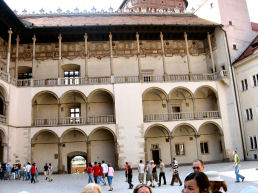
Kasia told us about the Warsaw uprising at the end of World War II. It lasted sixty-three days. Three hundred thousand Poles were killed. The Russians were camped on the other side of the river. They made no effort to help the insurgents. They waited until it was over and then occupied the city.
We went to the outer wall of the castle, where we were afforded a good view of Kraków and the Vistula (Wisła) River. Kasia indicated a hill near the city that had been constructed as a monument to Kosciusko. Kasia showed us a barely visible monastery that housed seven cloistered monks. Each had his own house. Women were allowed on the grounds of the monastery only nine days a year. I asked Kasia what order they were. She said that they were Italian. Their name was Kaduli or something like that. [Saint Romuald founded the Sacred Hermitage of Camaldoli in the eleventh century. The adjectival form is “Camaldolese” or “Camaldulian.” Pope Gregory XVI (1831-1846) belonged to this order.]Kasia pointed out some nearby apartment blocks. She told us about the ration cards that they had used for buying food and other goods under the communist system. Not much had been available, and they would have to wait in line for up to five hours. In some cases the people distributing the goods would cheat the people. Now there are rich people, a small middle class, and a lot of poor people.
We saw the statue of the legendary dragon down below us. The dragon consumed either virgins or cows, depending on the version of the story to which one subscribed. Kasia told us the tale of how the dragon was slain when Prince Krak gave him explosives wrapped in wool. The dragon thought that they were sheep and ate them. He jumped in the river and exploded.According to Kasia 50 percent of Kraków is owned by the Catholic Church! How in the world did J2P2 and Cardinal Stanisław pull that off? No wonder the economy is having problems.
Kasia asked me about all of the notes that I had been taking. I explained to her about my journal and my website. She said, “So it will say ‘Kasia said this, and Kasia said that.’” I acknowledged that there would be some of that. She laughed. I should have gotten her e-mail address so that I could let her read it and send me corrections if I got things wrong. I always forget to do things like that.
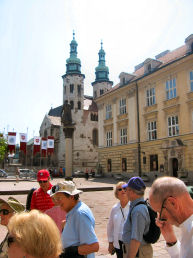
When we went back down to the Old Town evidently Susana stayed behind waiting for Sue. Since Sue had been there when we left. I assumed that she had let someone important know that she did not intend to participate in the walking tour. Lauren ended up calling Susana on her cell phone to tell her that Sue was at the hotel.
There were many signs touting the upcoming big celebration of the 1250th anniversary of the “location” of Kraków. I think “location” that must be roughly comparable to incorporating in our terminology.
We paid a quick visit to the St. Francis basilica and monastery, which was almost straight across the Planty from the hotel. It was the home of the home of the best-known works of the two famous Polish Art Nouveau artists, Stanisław Wyspiański and Jósef Mehoffer. At the far end were depictions of St. Somebody and St. Francis. Pam thought that the latter was a woman because the hood behind his head looked like hair. I corrected her. I think that she might have been annoyed at this. I needed to watch my mouth. I knew that I often came across as arrogant.
Kasia told us that some of the rural people in Poland drink spiritus (90 percent alcohol) with their tea.
We stopped and examined the collection of photos by Adam Broomberg of Pope John Paul II on display in the Planty. Patti expressed interest in purchasing a collection of his works. I was most interested in finding out the last name of Cardinal Stanisław. The write-up next to one of the photos said that it was Dziwisza. No wonder no one on my Italian tapes ever used his last name. An Italian tongue would have a tough time with all of those consonants. We stopped in for a moment at the administrative courtyard of Jagiellońskego University. It was eerily reminiscent of the courtyard we had visited at the university in Padua. In fact, just across the street was an establishment named "Ristorante Padva," a very strange name since the city is called Padova in Italy, and there is no letter v in Polish. This could hardly have been a coincidence. This university was built in the fourteenth century. Copernicus was a student here. John Paul II was another alumnus. The faculties were located in different parts of the Old Town. Most of the 120,000 (!) students lived in parts of town with more affordable accommodations and commuted to classes. I asked Kasia what the permanent population of Kraków was. She told me that it was around 800,000, but with the students it is around a million.We walked into the square. Kasia showed us a spot where the original square had been excavated. It was three meters lower than the rest of the square. Europe was built on the trash of its past. The Town Hall and the Cloth Hall date back to the thirteenth century.
The tour ended well before noon near St. Mary’s church. The idea was to attend the opening of the altar piece at St. Mary’s Church at noon. However, for some reason we dawdled around, and by the time that we got to the entrance of the church, it was judged to be too crowded.
We all heard the trumpet player announce the hour. I was unable to spot him in order to snap a photo. Everyone else explained to me where to look. There should be many more chances to get the photo.
I saw a guy in a Ctrl + Alt + Del tee shirt. He must be a Mac user.
We returned to the hotel. I needed to get my e-mail. Sue discovered that the hotel was wired and offered free Internet access! The people at the desk lent us a long Ethernet cable. I connected with no difficulty at all. Denise had sent me an e-mail with some questions. There did not seem to be any great emergencies. I answered her questions. I sent my dad an e-mail. I also sent him Maureen Dowd’s last two columns in eighteen point type so that he could read them.
Two things had come up over the last two days. Susana had said something about Copernicus’s works still being on the Index until the twentieth century. The Stroganoffs also were mentioned on the bus. I googled Copernicus and the Index. His work was removed from the Index in the 1750’s by Pope Benedict XIV. Prior to that time the original version of his work was indeed on the Index, but anyone could read a version with only six sentences redacted. I also googled Stroganoff. I was reminded that they were the wealthy Russian family that had made an incredible fortune in salt. This seemed appropriate, since we planned to go to a salt mine the following afternoon.
Several people in the group had brought their laptops. I certainly think that they would have been interested in the fact that the hotel had this feature. We ate lunch at the Miód Malina, a restaurant recommended by the guide book. It served Polish and Italian cuisine. I was ready for a change, so I ordered Pizza Capricciosa (with ham and mushrooms). Sue had Pizza “Cotto.” Patti had pierogis with sour cream and mushrooms. Tom had pig’s knuckles. The beer was Tyskie. I thought that the pizza was first rate, as good as any that I had eaten outside of Italy. I finished the whole thing. After our mid-afternoon meal the four of us walked over to the castle again. We wanted to see the statue of the dragon up-close, Unfortunately, we had to walk all the way around the castle to get there, At one point we had to decide whether to go up or down. I ran ahead and ascertained that down was correct. As we reached the river we saw the dragon. I took a photo, but I missed the fine. I waited for quite a few minutes before he did it again. I got a couple of decent shots.As we waited near the dragon, I noticed some young men and women who were giving away samples of Coca Cola Light, which is what they call Diet Coke over here. They seemed to be, however, quite careful not to give any to tourists. They certainly never offered me one. They must have been trying to establish the brand in Poland.
Around the statue of the dragon were several vendors with carts full of junk to sell to kids. I was surprised to see realistic-looking toy guns, including black plastic machine guns and machine pistols. This would certainly not be permitted in the U.S. any more. If a kid carried one of those in some parts of the U.S., he would be terminated with extreme prejudiced by a patriotic handgun-bearing adult within five minutes.The natives of Kraków use the paved path by the river for strolling, dog-walking, and other activities.
When we reached the castle, we decided to split up. The weather was beginning to become threatening. Tom and I went back in the church after I was satisfied that I had a decent photo of the bones.Inside again I went back to the Romanesque chapel in the courtyard side of the entrance. Most of the frescoes there had no perspective, so they were probably fourteenth century or earlier. In the middle was a big black bird. The Polish symbol is a white eagle; I assume that this one spent too much time in the sun. His wings and claws were visible, but he held a sword behind his head, so he must have had another armlike appendage. We then climbed up to the top of the bell tower. The six bells were huge, but there was not much to it. We went down to the crypts and saw the tomb of everyone who was anyone in the history of this part of the world.
Tom and I exited the church just as it started to sprinkle. We were supposed to meet the ladies at the little shelter above the stand where they solder amber and the like. Shortly after we got there it started to rain pretty hard. Other people joined us under the roof. One guy had a bag that advertised some sort of foreign policy conference in Kraków. Sue and Patti arrived. Evidently Patti had tried to buy some souvenirs with Czech money. When she realized the mistake, she tried to use her credit card, but she had forgotten to bring it with her. Sue ended up paying the bill. Patti gave her Czech money to Sue to use when we return on June 5. The four of us waited out the worst of the downpour and then headed back to the hotel. The storm quickly passed, We decided to go up and have a drink at the square.Unfortunately every café seemed to be packed. I was not in a good mood at all. I spotted two couples leaving a table at a bar called Folia. I called to the rest of the foursome and they joined me at the table. We sat there for about fifteen minutes. The waitress crawled over us to get to other patrons, but she made no effort whatever to take our order. Sue went and got some menus. We sat there for another ten minutes. Then we got up and left. Evidently we had violated some unpublished protocol.
Tom led us to a small pub called C.K. Browar outside of the Old Town. They had outdoor seating. There was a potential crisis at first when the waitress said that they did not have iced tea, which is what Patti wanted. However, the waitress located a Nestea can somewhere, so all was well. I was pretty much fed up with this approach to traveling. However, after a couple of beers I loosened up and had a pretty enjoyable time listening to Sue explain to Patti her plan, or lack of it, for the trip to Slanec castle. We got back to the hotel at about 11:00.